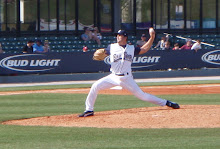Before Lee,
 Mike Mussina was also famous for throwing this tight spinning 12 to 6 or 11 to 5 (on the clock) breaking pitch. It gets its name as a Knuckle Curve (and also Spike Curve) because of the way the pitch is gripped. The middle finger is straight along the outer seam of the ball and the index finger is tucked underneath (similar to a knuckleball grip). I have had better success myself by sticking my fingernail directly into the seam of the ball. Either way, the knuckle is used to help accelerate the spin of the ball as it comes out of the pitchers hand by straightening the tucked finger at the release of the pitch. Typically, this will create a hard biting pitch that "spikes" downward, generally bouncing on the plate. Hence, the two reasons for the name.
Mike Mussina was also famous for throwing this tight spinning 12 to 6 or 11 to 5 (on the clock) breaking pitch. It gets its name as a Knuckle Curve (and also Spike Curve) because of the way the pitch is gripped. The middle finger is straight along the outer seam of the ball and the index finger is tucked underneath (similar to a knuckleball grip). I have had better success myself by sticking my fingernail directly into the seam of the ball. Either way, the knuckle is used to help accelerate the spin of the ball as it comes out of the pitchers hand by straightening the tucked finger at the release of the pitch. Typically, this will create a hard biting pitch that "spikes" downward, generally bouncing on the plate. Hence, the two reasons for the name.The other difference between the Cliff Lee breaking ball and your average curveball is hand position at release. With a typical curve, the hand turned clockwise at release to put breaking ball spin on the ball. The benefit of the Spike Curve ball is that than hand stays up and behind the baseball until release. Instead of the quarter turn as described above, the hand rolls over at release and the knuckle finger extends, applying spin to the ball. Without the hand turn, the pitch is even more difficult to pick up. It works especially well when the spin of the ball is exactly 12 - 6 (or end over end). Most hitters are unable to tell the difference between a breaking ball spinning end over end and a fastball spinning in the exact opposite direction. The delay in pitch recognition will be all it takes to make it too late for the hitter to adjust to the breaking ball.
So there you have, the Spike Curve (Knuckle Curve) explained!
Remember to check out the new website here (if you aren't already there) and register for the free content!!
Until next time!!!!

No comments:
Post a Comment